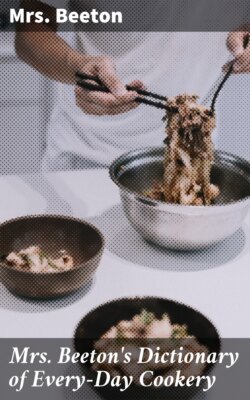Читать книгу Mrs. Beeton's Dictionary of Every-Day Cookery - Mrs. Beeton - Страница 217
На сайте Литреса книга снята с продажи.
CAKES, Making and Baking of.
ОглавлениеTable of Contents
Eggs should always be broken into a cup, the whites and yolks separated, and they should always be strained. Breaking the eggs thus, the bad ones may be easily rejected without spoiling the others, and so cause no waste. As eggs are used instead of yeast, they should be very thoroughly whisked; they are generally sufficiently beaten when thick enough to carry the drop that falls from the whisk.
Loaf Sugar should be well pounded, and then sifted through a fine sieve.
Currants should be nicely washed, picked, dried in a cloth, and then carefully examined, that no pieces of grit or stone may be left amongst them. They should then be laid on a dish before the fire, to become thoroughly dry; as, if added damp to the other ingredients, cakes will be liable to be heavy.
Good Butter should always be used in the manufacture of cakes; and, if beaten to a cream, it saves much time and labour to warm, but not melt, it before beating.
Less butter and eggs are required for cakes when yeast is mixed with the other ingredients.
The heat of the oven is of great importance, especially for large cakes. If the heat be not tolerably fierce, the batter will not rise. If the oven is too quick, and there is any danger of the cake burning or catching, put a sheet of clean paper over the top: newspaper, or paper that has been printed on, should never be used for this purpose.
To know when a cake is sufficiently baked, plunge a clean knife into the middle of it; draw it quickly out, and if it looks in the least sticky put the cake back, and close the oven door until the cake is done.
Cakes should be kept in closed tin canisters or jars, and in a dry place. Those made with yeast do not keep so long as those made without it.
